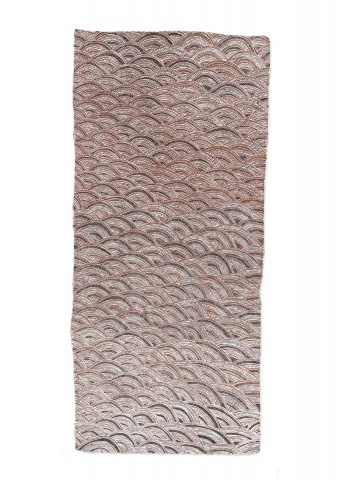RULYAPA, 2007
DHURRUMUWUY MARIKA
natural earth pigments on eucalyptus bark
121.0 x 58.0 cm (irregular)
bears inscription verso: artist’s name, date and Buku–Larrŋgay Mulka cat. 3313H
bears inscription on certificate attached verso: artist's name, title, medium, size and Buku–Larrŋgay Mulka cat. 3313H
Buku–Larrnggay Mulka Arts, Yirrkala, Northern Territory (label attached verso)
Annandale Galleries, Sydney
Private collection, Sydney acquired from the above in April 2008
YOUNG GUNS II: bark paintings & ceremonial poles, Annandale Galleries, Sydney, 16 April - 10 May 2008
This work is accompanied by a certificate of authenticity attached verso from Buku–Larrŋgay Mulka which states:
‘This miny’tji represents Rulyapa, the rough saltwater country between Nhulunbuy and the large island of Dhambaliya, ballooning up from the secret depths, around the sacred rock Manhala, which can be a manifestation of Daymirri. Daymirri is the whale (or perhaps sea monster) that according to Rirratjiŋu and Djambarrpuyŋu clan manikay (sacred song) pertains to the saltwater country close to Yirrkala. The dome–shamed rock Manhala exposes itself at the low tide, above the raŋ (tide marks), bleached white, a patina of brine and weather.
Manhala is one of many names given to the rock. Djambarrpuyŋu and Rirratjiŋu clans have many ‘deep’ names that intoned by the ritual specialists at the culmination of appropriate ceremony. The sea surrounding the rock, its tidal movements, differing states and the effect it has on Yolŋu visiting this site in Ancestral times is all recorded in the sacred song. As are all the totemic species of marine life that has these ancestral connections to the Rirratjiŋu and Djambarrpuyŋu. Often painted in this design is Daymirri the whale, Balpa the rock cod, Djumbarr the red emperor, Darrpa the king brown snake and Mutjalanydjal, the dolphin. All of these things and all of their meanings are implied simply by the presence of the miny’tji for the water.
It's not just Manhala and the power associated with deep seated knowledge that makes this area both sacred and dangerous to those entering it without authority. There are three other rocks in the area of same qualities but these ones; Wakwakbuy, Mulŋuwuy and Dharrpawuy, are submerged.
Dhumurruwuy is a young man painting in his first season as an artist at Gangan (2007–8). He of course is being encouraged to paint more for they are good, concerted solo efforts.’
